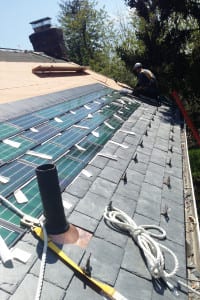The idea of installing solar panels to a roof as a source of electricity for a home is not exactly prehistoric.
Reducing the use of electricity or gas to power and heat homes undoubtedly has a positive effect on the environment. Despite being fairly new to the market, solar panels may be supplanted soon by a less expensive, more effective alternative.
Solar shingles have been available in the United States for about five years, according to an estimate by Richard Ciota, a Stony Brook resident who owns Division 7 Inc. Ciota’s 21-year-old roofing company is located in Lake Grove. Its residential division is the only one in the Suffolk County, Nassau County and New York City areas permitted to sell Dow Powerhouse solar shingles.
Solar panels have been available for decades, Ciota said in an interview at Division 7’s main office. They are at this point more efficient in generating electricity than shingles in terms of kilowatts per-square-foot of roof space, though there are problems associated with panels that contribute to the higher cost Ciota said.
“When you’re putting a solar panel onto a roof surface, you’re mounting that solar panel to the rafters through the existing roof,” Ciota said about the older technology, which his company offered prior to the availability of shingles. “So the waterproof technology has got to be perfect because you could be putting 40, 50, 60 penetrations through a perfectly good roof.”

Wind, shade from trees, excessive heat and animals are other factors that Ciota said are enemies to solar panels, which are installed on top of asphalt shingles and leave wiring exposed to the elements. Wind can cause the panels to pull the asphalt shingles away from the roof, which is an annoying and costly problem to have to fix after panels are installed.
Solar shingles replace asphalt shingles. They are waterproof and work in the same way that any conventional asphalt shingle would along with the added benefit of a reduced electric bill and a more environmentally friendly home than one that runs on electricity or gas heating.
Despite availability and the obvious benefits, solar panels only currently exist on about 5 percent of Long Island homes, according to Ciota. The number of homes with solar shingles is exponentially smaller.
John Petroski, Division 7’s director of solar and residential operations, estimated that the company has done about 70 shingle installations on Long Island since 2012 when Dow partnered with Division 7 Inc. Petroski said they have about 35 booked jobs left to complete, as part of Dow’s pilot program, which offered leasing or purchasing options to consumers.
“The way [Dow] is moving forward with the technology of the shingles, the improvements they’re making — they’re covering their bases,” Petroski said in reference to the notion that unanticipated issues have arisen as solar panels have gotten older, which could also happen to the shingles.
“I personally think the solar shingle will take over the marketplace,” Ciota said about the future as the technology continues to be upgraded. “There are new generations of solar shingles that will be coming out that will increase its efficiency and eventually they’ll probably tie up and meet [the efficiency of panels].”
Other companies sell solar shingles on Long Island, though Dow’s are widely considered to be on the cutting edge. In 2012 Dow received a Breakthrough Award from the magazine Popular Mechanics for pioneering an integrated solar roofing system, according to a press release on Dow’s website.
Note: John Petroski, director of solar and residential operations, is this writer’s brother.





